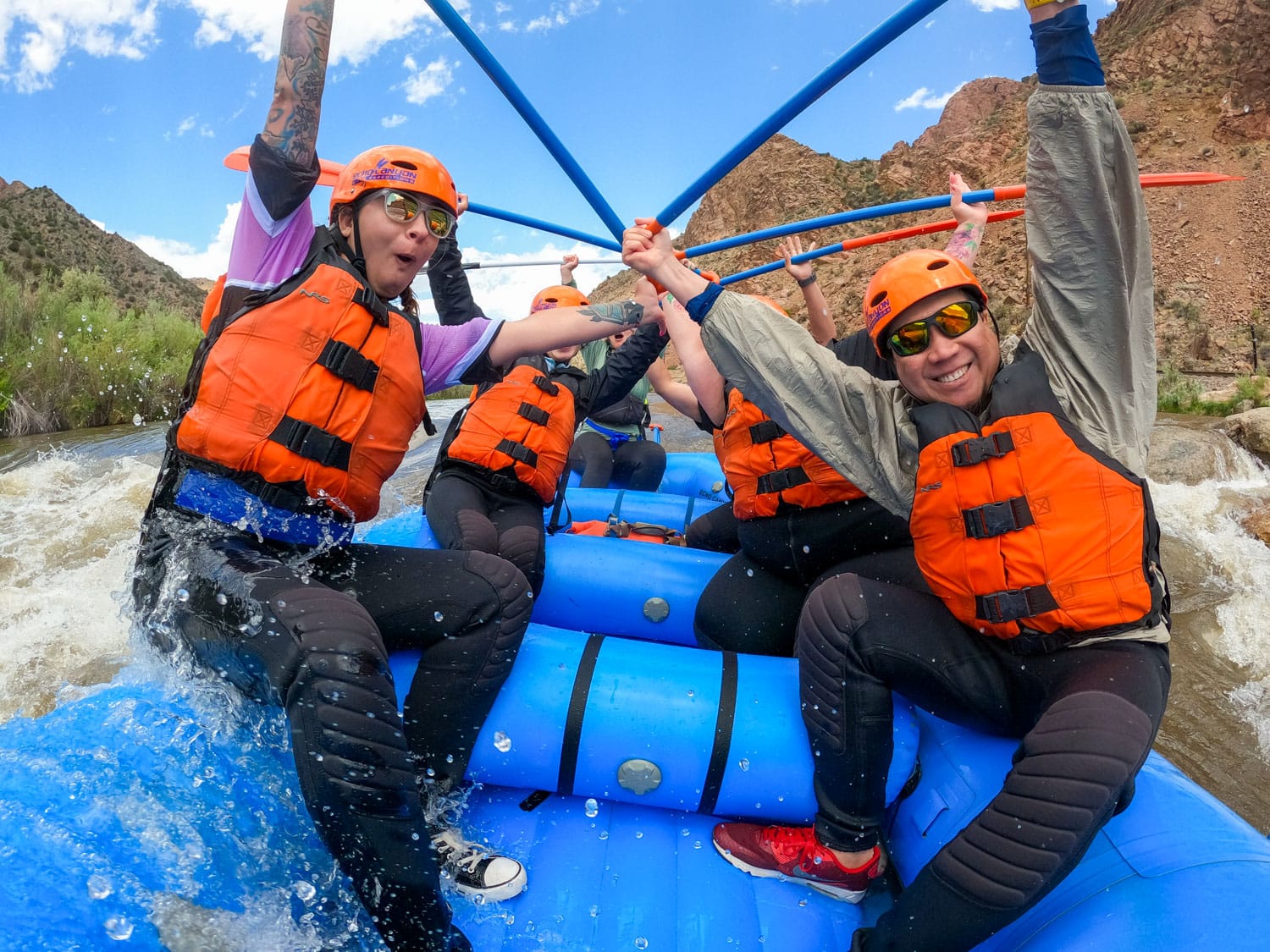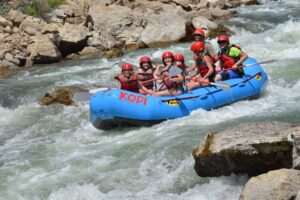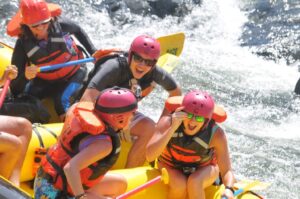Wear quick-drying clothing and appropriate footwear for whitewater rafting. Whitewater rafting is a thrilling outdoor activity that involves navigating fast-moving rapids in a raft.
It can be a great way to get some exercise and enjoy the great outdoors. If you are planning to go whitewater rafting, it’s important to dress appropriately to ensure your safety and comfort. Wearing the right clothes and footwear can prevent hypothermia and other injuries, so you can fully enjoy your adventure.
In this article, we’ll cover some tips on what to wear for whitewater rafting and some other essential items to pack for your trip.

Credit: www.raftecho.com
What To Consider Before Picking Your Outfit
Whitewater rafting is a thrilling and adventurous activity that requires the right outfit to ensure safety and comfort. However, choosing what to wear can be tricky and overwhelming, especially for beginners. In this post, we will be discussing what to consider before picking your outfit, with a focus on weather conditions and water temperature, the length of the trip, type of raft, and level of expertise.
Weather Conditions And Water Temperature
Knowing the weather conditions and water temperature at the time of your rafting trip is crucial in choosing the right outfit. Here are some key points to consider:
- Check the weather forecast before your trip and prepare accordingly.
- In warm weather, it’s best to wear light and breathable clothing to keep cool.
- In cold weather, dress in layers to keep warm.
- Water temperature can vary, so it’s important to wear appropriate neoprene gear.
- Your guide can provide wet suits and splash jackets if necessary.
Length Of The Trip
The length of your whitewater rafting trip can impact what to wear, specifically in terms of comfort and durability. Here are some key points to consider:
- Longer trips might require comfortable, quick-drying clothing and a change of clothes for after the trip.
- Choose sturdy shoes with excellent traction and avoid flip-flops.
- Wear sunglasses with a strap to protect your eyes from the sun and water.
Type Of Raft
Different types of rafts require different types of clothing to ensure comfort and safety. Here are some key points to consider:
- Oar rafts or paddle rafts may require different clothing depending on your level of involvement.
- Prepare for getting wet, especially in small rafts.
- Ensure that your clothing allows for a full range of motion.
Level Of Expertise
Your level of expertise can also impact what to wear for whitewater rafting. Here are some key points to consider:
- Beginners should consider wetsuits and splash jackets to ensure warmth and protection.
- Experienced rafters may prefer lighter clothing that allows for better mobility.
- Always consult with your guide to determine the appropriate outfit for your level of experience.
When choosing what to wear for whitewater rafting, consider the weather conditions and water temperature, length of the trip, type of raft, and level of expertise. Ensuring you have the proper outfit can enhance your experience by keeping you safe, comfortable, and having a good time.
Essential Rafting Attire For Maximum Safety
Whitewater rafting is a thrilling activity that requires proper attire to ensure maximum safety. When going on a rafting trip, it is important to wear the right gear to protect yourself from potential hazards. In this section, we will discuss the essential rafting attires for maximum safety.
Helmets
One of the most vital pieces of gear to wear when whitewater rafting is a helmet. It is essential to wear a helmet that fits snugly and securely on your head. Here are some key points to consider when choosing a helmet for rafting:
- Choose a helmet that is specifically designed for water sports, with a hard and durable exterior that can withstand impacts
- Make sure the helmet has enough padding on the inside to provide comfort and protection
- Check that the helmet fits securely and comfortably on your head, without being too tight or too loose
- Always wear a helmet when rafting, even if the water looks calm, to protect your head from potential impacts with rocks and other obstacles
Life Jackets
Another crucial piece of safety gear when rafting is a life jacket, also known as a personal flotation device (pfd). Wearing a properly fitting life jacket can save your life in an emergency. Here are some key points to consider when choosing a life jacket:
- Choose a life jacket that is approved by the us coast guard and specifically designed for whitewater rafting
- Make sure the life jacket fits you snugly and comfortably, without being too tight or too loose
- Check that the life jacket has enough buoyancy to keep you afloat in fast-moving water
- Always wear a life jacket when rafting, even if you are a strong swimmer and the water looks calm
Wetsuits And Drysuits
When rafting in cold water, wearing a wetsuit or drysuit is essential to prevent hypothermia. A wetsuit is designed to keep you warm by trapping a thin layer of water between your body and the suit, which is then heated by your body’s warmth.
A drysuit is designed to keep you completely dry by preventing water from entering the suit. Here are some key points to consider when choosing a wetsuit or drysuit:
- Choose a wetsuit or drysuit that is appropriate for the water temperature and weather conditions
- Make sure the suit fits you snugly but allows for freedom of movement
- Check that the suit is made of high-quality neoprene or waterproof material
- Always wear a wetsuit or drysuit when rafting in cold water to prevent hypothermia
Water Shoes
Finally, wearing appropriate footwear when rafting is important to protect your feet from rocks and other hazards in the water. Water shoes are designed to provide traction and support on slippery surfaces and are made of breathable, quick-drying materials. Here are some key points to consider when choosing water shoes:
- Choose water shoes that are specifically designed for water sports and have a non-slip sole and good traction
- Make sure the shoes fit securely and comfortably on your feet
- Check that the shoes are made of a quick-drying and breathable material, such as mesh or neoprene
- Always wear water shoes when rafting to protect your feet and provide traction on slippery surfaces.
Whitewater rafting can be an exhilarating experience, but it is important to wear the right gear to ensure maximum safety. Helmets, life jackets, wetsuits/drysuits, and water shoes are all essential pieces of attire that can protect you from potential hazards on the water.
Remember to always choose gear that is appropriate for the water temperature and weather conditions and fits you comfortably and securely. Happy rafting!
Other Recommended Clothing For Optimum Comfort
Whitewater rafting is an exciting outdoor activity that requires proper planning, especially when it comes to clothing. Keeping comfortable and safe is key! While you’ll have to prepare for lots of water and some hard paddling, choosing the right clothes can make a world of difference in your experience.
Below are some recommended clothing for optimum comfort:
Quick-Drying Clothes
It’s essential to wear clothes that dry up quickly, especially when you know you’ll be in constant contact with water. You should avoid cotton clothes, as they absorb water and take longer to dry, making you feel heavy and uncomfortable.
Instead, consider wearing quick-drying synthetic fabrics such as nylon, polyester, or spandex. They are lightweight, comfortable, and easy to move around in.
Recommended quick-drying clothes for whitewater rafting:
- Nylon shorts
- Polyester t-shirts or tank tops
- Spandex leggings or shorts
- Quick-drying swimsuits
Sun Protection
Whitewater rafting involves being under direct sunlight for an extended period, so sun protection is crucial. Sunburn can spoil your experience and make you feel uncomfortable. Therefore, you must wear and carry sun-protective clothing and accessories, such as sunscreen, a hat, and sunglasses.
Recommended sun-protective clothing for whitewater rafting:
- Wide-brimmed hat or baseball cap
- Polarized sunglasses with uv protection
- Long-sleeved and lightweight shirt with upf (ultraviolet protection factor) rating
- Sunscreen with a minimum of spf 30
Insulation Layers
Even on a hot summer day, it’s essential to pack insulation layers for your whitewater rafting trip. River water is usually cold, and air temperatures can drop at higher altitudes. Wearing insulation layers will help regulate your body temperature and keep you warm throughout your trip.
Recommended insulation layers for whitewater rafting:
- Fleece jacket or vest
- Wetsuit or drysuit (depending on the water temperature)
- Neoprene booties or socks
Hats And Sunglasses
Wearing a hat and sunglasses can protect your face and eyes from the sun and also keep hair out of your eyes, ensuring a better visibility experience. A hat and sunglasses can make a difference when there’s direct sunlight getting in your face and makes it a more enjoyable experience.
Recommended hats and sunglasses for whitewater rafting:
- Polarized sunglasses with uv protection
- Baseball cap or wide-brimmed hat
Wearing the right clothing is essential for a comfortable and safe whitewater rafting experience. Always remember to pack quick-drying clothes, sun protection, insulation layers, and hats and sunglasses. With these recommended clothing items, you’ll be set and ready to take on your next whitewater rafting adventure!
Warm Weather Whitewater Rafting
Whitewater rafting is a thrilling and action-packed adventure, but the excitement should not overshadow the importance of dressing right for it. Since the weather plays a significant role in determining what you should wear for your rafting trip, let’s take a closer look at what to wear for warm-weather whitewater rafting.
Lightweight And Breathable Clothing
Whitewater rafting can be a strenuous activity, and you’re bound to get wet. Opt for lightweight, breathable clothing to stay cool and comfortable. Here are a few things to keep in mind:
- Avoid cotton as it retains water and can get heavy; instead, wear synthetic fabrics like polyester or nylon that wick away moisture and dry quickly.
- Long-sleeved shirts and pants can protect you from the sun and prevent a nasty sunburn.
- A hat with a wide brim can shield your face and neck from the sun.
Sunscreen And Sunglasses
The sun’s rays can be harsh, especially when reflected off the water. Sunscreen and sunglasses are two essential items that you must have on your checklist for your rafting trip. Here’s what you should know:
- Use a waterproof, high spf sunscreen to protect yourself from harmful uv rays.
- Wear sunglasses that wrap around your face and have polarized lenses that reduce glare and protect your eyes from the water’s reflections.
Water Shoes Or Sandals
Your footwear choices for whitewater rafting should prioritize comfort, stability and protection. Here are a few tips:
- Wear water shoes or sandals that have good traction and grip, as you’ll be scrambling over rocks, walking in the shallow parts and slipping around in the water.
- Avoid flip-flops or crocs as they can fall off or get swept away in swift currents.
Quick-Drying Towel
A quick-drying towel is an often-overlooked yet critical clothing item that can make all the difference in ensuring comfort and hygiene throughout your rafting trip. Here’s why you should pack one:
- You’ll need to dry off between water sections, and a quick-drying towel is perfect for this.
- Even if you don’t plan on swimming, you may end up getting wet in the rapids, and having a towel can help get you dry quickly.
Dressing appropriately for your warm-weather whitewater rafting experience can make the difference between an enjoyable and comfortable trip or a miserable one. Wear lightweight, breathable clothing, pack sunscreen and sunglasses, wear comfortable shoes or sandals, and bring a quick-drying towel for optimal comfort and safety.
Cold Weather Whitewater Rafting
Whitewater rafting is an exciting outdoor activity that requires appropriate clothing depending on the weather conditions. When it comes to cold weather, you need to enhance your apparel to keep warm and dry. In this blog post, we will discuss the key gear to wear for cold weather whitewater rafting.
Waterproof Insulated Jacket And Pants
A waterproof insulated jacket and pants will keep you dry and warm. Here are the key characteristics to consider when purchasing these items:
- Waterproof: Look for materials explicitly designed to keep water out. Gore-tex and hyprotex are common materials that prevent water from penetrating through the fabric.
- Insulated: Good insulation is essential to retain heat. Insulation materials include down or synthetic fill.
- Breathable: A breathable jacket and pants allow sweat to evaporate, keeping you dry and comfortable.
Neoprene Booties
Neoprene booties are an excellent option to keep your feet dry and warm.
- Insulated: Look for neoprene booties with insulation materials to keep your feet warm, such as 2mm or 3mm neoprene.
- Traction: Choose neoprene booties with a rubber sole that offers excellent traction on wet and slippery surfaces.
Gloves And A Hat
Your hands and head are the most exposed body parts during cold weather rafting. Gloves and a hat are crucial gear to wear.
- Gloves: Waterproof gloves are essential to keep your hands dry. Look for gloves with insulation materials such as fleece or wool.
- Hat: A close-fitting waterproof hat made of fleece or wool retains heat and keeps your head dry.
Fleece Or Wool Layers
Fleece or wool layers are a great way to keep warm and comfortable during cold weather rafting. Fleece and wool layers are:
- Insulated: They provide excellent insulation and retain heat, keeping you warm.
- Breathable: Fleece and wool layers allow sweat to evaporate, keeping you dry and comfortable.
Cold weather whitewater rafting requires appropriate gear to keep you warm and dry. A waterproof insulated jacket and pants, neoprene booties, gloves and a hat, and fleece or wool layers are essential gear when rafting during cold weather. Remember to pick high-quality gear that is breathable, insulated, and waterproof to make your experience comfortable and enjoyable.
Clothes To Avoid
Whitewater rafting is an adventure sport that is both thrilling and challenging. As much as it is a fun activity, it is necessary to take safety precautions. One of the most crucial things you need to consider is what you wear for the trip.
Here we have some tips on what clothes to avoid on your next whitewater rafting trip.
Cotton Clothing
Cotton is not suitable for whitewater rafting because it holds moisture and takes a long time to dry. When you’re out on the rivers, chances are you’ll get wet, and you don’t want to stay in wet clothes for too long.
Cotton underwear, socks, and t-shirts will retain water, leading to discomfort and potentially hypothermia. Avoid cotton clothing and choose quick-drying, moisture-wicking fabrics instead.
Baggy Clothing
Loose, baggy clothes are notorious for getting caught by various bits of equipment or branches, which can be dangerous. Baggy clothing can quickly get entangled with paddles or ropes, which can lead to accidents. It is essential to wear clothes that fit snugly and will not hinder your movement.
Here are some things you should avoid:
- Loose shorts or pants that can get caught in the gear
- Baggy t-shirts or tank tops that may impair your arm movement
- Oversized jackets that can get trapped between boat surfaces or branches
Open-Toed Shoes
Another item you should avoid on your whitewater rafting trip is open-toed shoes. When you’re in the water, your feet can quickly slip out of the shoes, leaving you vulnerable to sharp rocks and debris. Not only can this be painful, but it can also be dangerous, especially in fast-moving water.
Open-toed shoes also offer little protection and support to your feet.
Flip Flops
Avoid wearing flip flops when you go whitewater rafting. While they may seem comfortable, they are not designed for sports or outdoor activities. Your feet can easily slide out of flip flops, leaving you prone to injuries. You are much better off wearing appropriate footwear, such as water shoes, that can protect your feet and provide stable footing.
When planning what to wear for your next whitewater rafting expedition, avoid cotton clothing, baggy clothing, open-toed shoes, or flip flops. Instead, wear comfortable, lightweight, and quick-drying clothes that fit snugly and appropriate shoes that can protect your feet. A little attention to detail when dressing for your trip can make a big difference in your safety and enjoyment of the expedition.
Frequently Asked Questions Of What Should You Wear For Whitewater Rafting
What Should You Wear For Whitewater Rafting?
You should wear a wetsuit, quick-drying clothes, and water shoes. Avoid cotton and denim. Wear a life jacket and a helmet.
Can You Wear Glasses While Whitewater Rafting?
Yes, you can wear glasses, but you need to secure them with a strap. Consider using prescription goggles as an alternative.
Do You Need To Bring A Change Of Clothes For Whitewater Rafting?
Yes, it is recommended to bring a change of clothes, a towel, and a plastic bag for wet clothes. Keep them in a dry bag during rafting.
Conclusion
After reading this article, you should feel confident about what to wear when whitewater rafting. We have covered everything from the essential clothing items to accessories that could come in handy on your trip. Remember to prioritize safety by wearing a properly fitted life jacket and contacting your rafting company beforehand for any equipment recommendations or restrictions.
It’s important to dress for the weather and water temperature, and avoid wearing cotton for its water-retaining properties. By following these tips and being prepared for your whitewater rafting experience, you’ll have a much more enjoyable and comfortable trip. So, get ready to tackle those rapids in style and make unforgettable memories!


